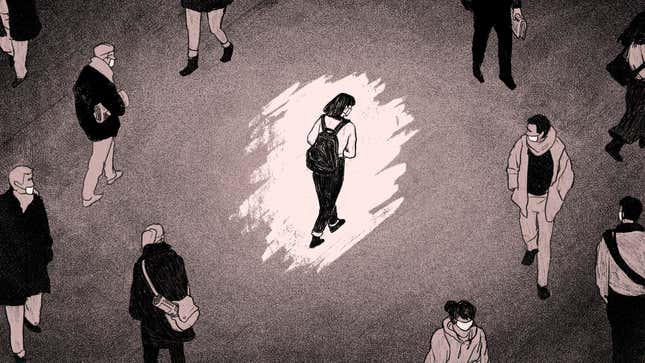The Persistence of 'Yellow Peril'
Latest
Illustration: Angelica Alzona
I have been playing a strange sort of game lately, one in which I attempt to discern the motivations behind the long looks I’ve been getting from strangers, looks in which I detect more than a tinge of hostility. The glare from the driver of the car next to me (I stared back until he looked away) as we were both stopped at a red light; the disgust on the face of the man sitting across the aisle from me the last time I flew on a plane, as I disinfected my tray table and armrests and seatbelt with a Clorox wipe and slipped on a surgical mask that my mom had insisted I take before I flew back home to New York City; the woman who quickly and without hesitation walked out of an elevator just moments after I stepped in after her.
At times, it’s more than just a lingering stare. Last week, a woman clutching a mini-stun gun in her hand at the grocery store told me to get out of her way, as I was shopping for myself and a couple of my elderly neighbors. I heard a crackling in the air; it was only as she walked away that I realized she had discharged the stun gun in my direction. Was she reacting to my face, half-covered by a mask? “I wish she had called me a dirty chink bitch, just so I would KNOW,” I quipped in a text to some of my friends afterward. Even now, I find myself downplaying all of the slights, making light of what feels increasingly heavy lately, like a lot of my Asian American friends, a defense mechanism to blunt the sharp edges. (We’re all Chinese now, in the racist imaginary. As the Korean American writer Cathy Park Hong noted tartly in her recent essay collection Minor Feelings, “Most Americans know nothing about Asian Americans. They think Chinese is synecdoche for Asians the way Kleenex is for tissues.”) Stepping outside is now fraught with a dual danger. My friends and I now joke about all the extreme measures we’re now taking to not cough in public; we’ve all gotten very good at discreetly clearing our throats.
We joke because we are suffused with a low-key paranoia, some of us for the first time, that other people’s irrational fear and hatred may render our individual humanity into a collective tragedy. Black Americans have known this reality since before the official founding of the United States; for all other people of color, our bitter reward for living in this country is getting our own time in the floodlights at some point. For South Asian Americans and Muslim Americans, it was 9/11 that unleashed a wave of bigots; for Latinx Americans, the election of Donald Trump led to a sharp uptick in hate violence. The likening of the covid-19 pandemic to war and specifically to Pearl Harbor is perhaps then unintentionally illuminating—in war, you have an enemy with a face, one that you have to dehumanize in order to justify the violence perpetrated against them, and well, we all know who that was in the U.S. after Pearl Harbor, and what happened in its wake—the easy vilification of Japanese Americans, the internment camps.
Today, the all-too-predictable response on the part of some casual bigots has been to target anyone they perceive to be Chinese, from verbal harassment to physical attacks. In New York City, an Asian women wearing a facemask was beaten, the man shouting, “Don’t fucking touch me,” calling her a “diseased bitch” to make it obvious; this week, an Asian woman was doused with acid, sending her to the hospital with second-degree burns. In California’s San Fernando Valley, a teenage boy was sent to the ER after some of his classmates accused him of having the coronavirus and attacked him. The violence has not been limited to coastal cities with large Asian populations. In Midland, Texas, a 19-year-old stabbed a Burmese man and his two young sons at a Sam’s Club, slashing the young boy across his face. According to the FBI, “The suspect indicated that he stabbed the family because he thought the family was Chinese, and infecting people with the coronavirus.” The attackers have been white, black, Latinx, eluding an easier binary and an easier story to tell, of white hatred and Asian victimization.
-

-

-

-

-

-

-

-

-

-

-

-

-

-

-

-

-

-

-

-

-

-

-

-

-

-

-

-

-

-

-

-

-

-

-

-

-

-

-

-








































